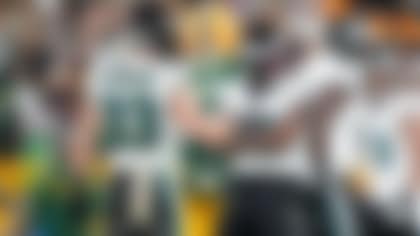This is the story of eight NFL teams that went into the 2011 NFL Draft with a quarterback need.
It also could serve as a roadmap for those that go into the 2014 NFL Draft in that very position.
At the end of last week, a few of the final pre-draft turns of the 2014 quarterback carousel were taken. Ryan Fitzpatrick signed in Houston, which helped push the trade of Matt Schaub to Oakland over the goal line. With the Raiders out of the quarterback trade market, the Jets finally cut Mark Sanchez loose and brought in Michael Vick.
The end result of that, and moves made over the previous three weeks, is this: The teams in the top 10 aren't obligated to take quarterbacks with their respective picks. The Texans have Fitzpatrick. The Jaguars have Chad Henne. The Browns have Brian Hoyer. The Raiders have Schaub. The Buccaneers signed Josh McCown. The Vikings re-signed Matt Cassel.
All except for Hoyer will make more than $3.5 million in 2014, and all can serve as a bridge to whomever their respective franchises' quarterbacks of the future end up being, whether they come in the first round, the second round or next year.
"All those teams in the top 10, they're all in position to draft a top-three quarterback. And all those teams, when you look at their offseasons, they needed to address the quarterback position, and they all did," one AFC personnel director said. "And all could select one of these quarterbacks, but they also have the flexibility, as they work through the final stages of the process. No. 1, it's insurance. No. 2, it's flexibility."
Here's where you go back to 2011 and look at the Panthers, Titans, Jaguars, Vikings, Bengals, 49ers, Dolphins and Redskins. The Panthers took Cam Newton first overall. The Titans, Jaguars and Vikings took Jake Locker, Blaine Gabbert and Christian Ponder at the eighth, 10th and 12th spots, respectively. The Bengals waited, taking receiver A.J. Green fourth overall and Andy Dalton in the second round. The Niners did the same, going with pass rusher Aldon Smith at No. 7, then grabbing Colin Kaepernick one pick after Dalton. The Dolphins and Redskins punted entirely, respectively taking center Mike Pouncey and pass rusher Ryan Kerrigan in the first round -- before both going QB in Round 1 in 2012 (Ryan Tannehill and Robert Griffin III).
The lesson here is not hard to learn.
Tempting as it might be to take a quarterback in the first round, clubs can be prone to manufacturing franchise players at the position when they aren't really there. And this could be another one of those years where the draft class is exceptionally strong -- as it was in 2011, given that 12 of the top 16 picks already have gone on to make a Pro Bowl -- but with serious questions hovering over the top guys at the most important position.
"I'd be scared to death (to take one of the quarterbacks high)," one NFC college scouting director said. "Teams like Jacksonville and Oakland have to debate that. You look at, say, an AJ McCarron, and he has traits like some of the really good ones, and you can get that guy at the end of the first round or top of the second and develop him, with not as much pressure as someone taken with a top-five pick. And then with the high pick, you take the best player. There's merit to it."
The hit rate on first-round quarterbacks has never been near perfect, but as the importance of the position has ascended, the bottom has dropped out on the percentages. Nine quarterbacks were drafted in the first round from 2009 to 2011. Four of them (Mark Sanchez, Josh Freeman, Tim Tebow and Gabbert) have been jettisoned by their drafting teams, and two of those guys are among the four (Sanchez, Tebow, Newton, Matthew Stafford) who have started playoff games among the group.
Brandt: QBs on the trash heap
Gil Brandt runs through five former first-rounders who flamed out at QB. What went wrong? And is there any hope for redemption? **READ**
The risk of failure is high in any year. And there are more questions this year than most.
"Just average," is how one NFC personnel exec described this QB class. "The kid from Central Florida (Blake Bortles) has a chance to be really good. (Johnny) Manziel scares me -- he's 50-50. (Teddy) Bridgewater reminds me a little of Byron Leftwich, in that he's a little soft. (Derek) Carr's just good. You take one of them in the third round, you're happy with that. The problem is, if you really want one of these guys, you almost have to take them in the first."
Several high-level evaluators said four players appear to stand out in this year's class: South Carolina defensive end Jadeveon Clowney, Buffalo outside linebacker Khalil Mack, Auburn offensive tackle Greg Robinson and Clemson receiver Sammy Watkins.
The NFC personnel exec opined that Bortles, if given a pure grade based on his potential, would probably fall in a cluster of eight or so players behind those top four. The rest, he said, might not be any better than second-round talents.
But quarterbacks almost always get overdrafted -- mostly when a team likes a guy enough, and then gets fearful he won't last long enough for the club to play it patient. And so it seems a good bet someone will be rolling the dice in May on a player many others aren't sold on.
"I'm a big Blake Bortles fan -- he has the 'it' factor in the way he carries himself. I can see that helping him succeed, and he can probably still gain 20 pounds," one AFC offensive coordinator said. "The other guys I'm really scared of. I didn't like Bridgewater before the workout and I don't like him after it. With the free time he'll have, and the offseason there is at this level, Manziel scares me. It's tough."
Tough because if you don't have one, you're looking for the guy. And it's also tough because drafting the wrong guy can be a bigger problem than passing on a group altogether.
So the operative question now, after a couple weeks of free agency, is whether or not the league is, en masse, starting to react to past stories of failure.
The aforementioned additions of veteran backup quarterbacks, who can serve as a bridge for a year or two, might be early evidence that it's happening.
"None of these quarterbacks that are there are the kinds of guys you jump up and down about," the NFC college director said. "They all have their flaws and question marks."
Punting can be risky, too. Florida State's Jameis Winston and Oregon's Marcus Mariota both will be eligible for the 2015 NFL Draft, and each has promise. But maybe the guy the pros like most is Penn State's Christian Hackenberg, who can't declare for another two years.
The fact is, eventually, you have to find your guy somewhere. Some sell out at the top of the draft. Others, like Seattle, keep throwing darts (Charlie Whitehurst, Tarvaris Jackson, Matt Flynn) until they hit (Russell Wilson) while building the team to surround the eventual leader.
There isn't a simple answer here. And when the draft class is strong at other positions -- as this year's is -- the conundrum is hard to miss.
"You can talk yourself out of taking the best guy, no doubt," the NFC personnel exec said. "Say you have three guys you like. And these two are better players, but the quarterback, he's gonna touch the ball on every snap. You can talk yourself out of taking a really good player. You'd say, 'We can find a pass rusher, or a corner, but we can't find a quarterback so easily.' And then you take the wrong guy."
And the AFC personnel director adds, "If you don't have a quarterback, it's hard to have some level of hope; it can feel like a futile effort. ... But if you miss? You set your franchise back two to three years."
The follies of 2011 are easy to spot now, of course. But if you're a club needing a quarterback of the future, it's not exactly an easy misstep to avoid.
Follow Albert Breer on Twitter @AlbertBreer.



